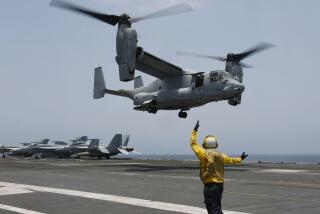Blame It on Your Buddies
- Share via
In the last three months five UH-1 helicopters supplied by the United States to the Philippines air force have crashed, with the two most recent accidents taking the lives of 11 officers. This has led some Filipino commentators, politicians and senior military officers to charge the United States with dumping inferior equipment on its ally. Adding to a growing climate of anti-Americanism, some Filipinos even accuse the United States of deliberately undercutting their country’s anti-insurgency program so that it will have an excuse to step in and take over.
The U.S. military aid program to the Philippines in the post-Ferdinand Marcos era has in fact been something less than a model of generosity or efficiency. Congress, while cheering the restoration of democracy in the Philippines, has proven curiously uneager to fund equipment transfers to the run-down armed forces that are supposed to protect that democracy. In some cases the military aid sent has been absurdly inappropriate, e.g., cold-weather gear for use in a tropical country. President Corazon Aquino’s recent claims that the United States has reneged on promised military help have added fuel to the fires of anti-Americanism.
Some complaints by Filipinos are understandable. At the same time it’s increasingly clear that blaming the United States for the Philippines’ problems in confronting its Communist-led insurgency has become an easy substitute for honestly acknowledging the failures of the country’s leaders to deal on their own with continuing political, military and economic failures. There are even now too few signs to indicate that serious steps are under way to rectify these failures. There are ample signs, though, that the insurgency will likely grow in strength. That in turn could provide further temptations for anti-American blame laying.
In the particular matter of the UH-1 helicopters it appears that the United States is being unfairly accused. For one thing the UH-1s, while old, are not cast-off junk; the U.S. Army continues to use them. For another, as Philippine air force records obtained by The Times show, the helicopter fleet has been plagued by serious maintenance problems.
Moreover, in the case of the most recent crashes, the commander of the Philippine air force confirms that both UH-1s “took off at night and in bad weather in violation of regulations.” These facts hardly support an implication of American responsibility for the accidents that have occurred.
Factually rooted or not, anti-Americanism is unlikely to disappear anytime soon in the Philippines. The reasons are familiar. Filipinos resent their dependence on the United States, even as they recognize that for the time being that dependence must go on. A new sense of nationalism revives old animosities against the United States as the former colonial occupier of the country. That nationalism encourages proposals to shut down the huge U.S. naval and air facilities in the country. But Filipinos also know that if these bases go, together with the nearly 40,000 Americans associated with them, hundreds of millions of dollars would be drained annually from their already enfeebled economy and tens of thousands of jobs will disappear.
The United States could indeed be doing more to help get the Philippines through troubling times. But achieving productive economic change and greater social equity in an effort to ease the popular grievances that feed the rebellion is up to Filipinos themselves. The leadership class can engage in all the Yankee-bashing it likes. Until it accepts its own responsibilities the country’s problems will almost certainly continue to grow worse.
More to Read
Sign up for Essential California
The most important California stories and recommendations in your inbox every morning.
You may occasionally receive promotional content from the Los Angeles Times.













